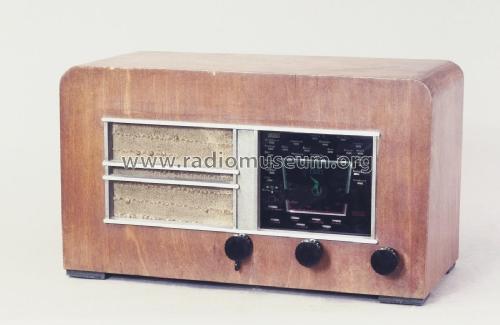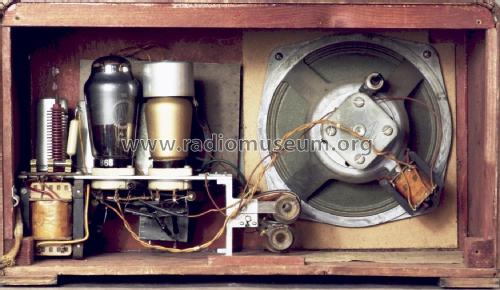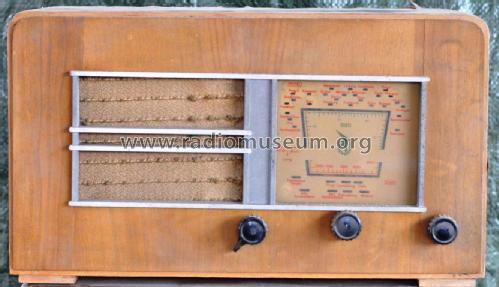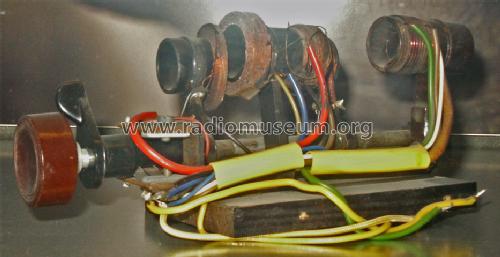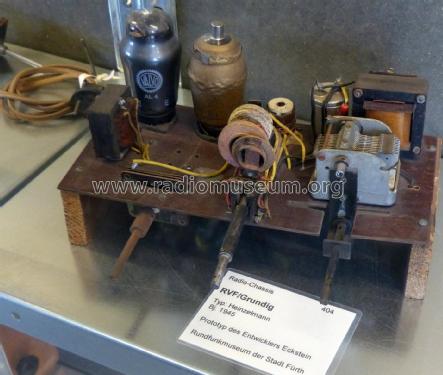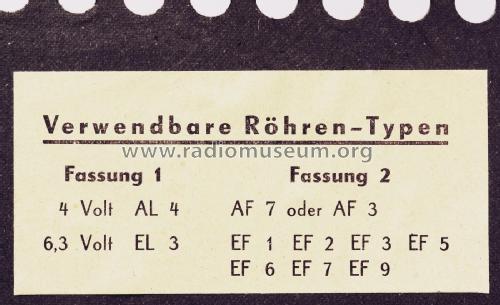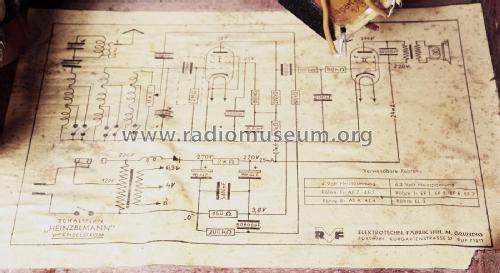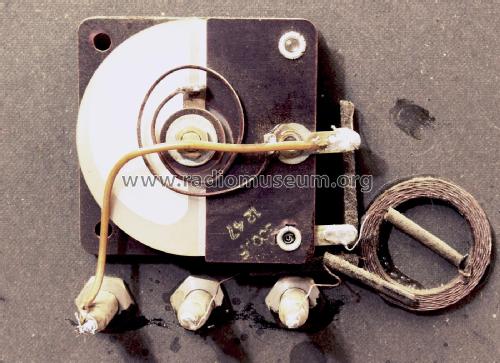Heinzelmann W 4 Volt
Grundig (Radio-Vertrieb, RVF, Radiowerke)
- Country
- Germany
- Manufacturer / Brand
- Grundig (Radio-Vertrieb, RVF, Radiowerke)
- Year
- 1946–1948
- Category
- Broadcast Receiver - or past WW2 Tuner
- Radiomuseum.org ID
- 1824
-
- alternative name: Grundig Portugal || Grundig USA / Lextronix
Click on the schematic thumbnail to request the schematic as a free document.
- Number of Tubes
- 2
- Number of Transistors
- Semiconductors
- Selengleichrichter
- Main principle
- TRF with regeneration; 1 AF stage(s)
- Tuned circuits
- 1 AM circuit(s)
- Wave bands
- Broadcast, Long Wave and Short Wave.
- Power type and voltage
- Alternating Current supply (AC) / 120/220 Volt
- Loudspeaker
- Permanent Magnet Dynamic (PDyn) Loudspeaker (moving coil) / Ø 17 cm = 6.7 inch
- Material
- Wooden case
- from Radiomuseum.org
- Model: Heinzelmann W [4 Volt] - Grundig Radio-Vertrieb, RVF,
- Shape
- Tablemodel, low profile (big size).
- Dimensions (WHD)
- 425 x 250 x 220 mm / 16.7 x 9.8 x 8.7 inch
- Notes
-
1. Baukasten; diverse Röhren verwendbar; 4-V-Trafo.
Hier finden Sie etwas zum Radioprogramm von Grundig.
und hier: Die Techniken der Heinzelmänner von RVF und GRUNDIG
- Net weight (2.2 lb = 1 kg)
- 4.5 kg / 9 lb 14.6 oz (9.912 lb)
- Source of data
- Radiokatalog Band 1, Ernst Erb
- Circuit diagram reference
- Lange-Nowisch
- Mentioned in
- Funkschau (10/1978, S. 442 - 445 / Bericht Max Grundig 70 Jahre)
- Literature/Schematics (1)
- -- Schematic
- Picture reference
- Das Gerät ist im Doppelband "Historische Radios" von Günther Abele abgebildet.
- Other Models
-
Here you find 6196 models, 5420 with images and 4190 with schematics for wireless sets etc. In French: TSF for Télégraphie sans fil.
All listed radios etc. from Grundig (Radio-Vertrieb, RVF, Radiowerke)
Collections
The model Heinzelmann is part of the collections of the following members.
Museums
The model Heinzelmann can be seen in the following museums.
Forum contributions about this model: Grundig Radio-: Heinzelmann W
Threads: 4 | Posts: 22
Hallo Radiofreunde,
Wurde der Grundig Heinzelmann Baukasten "RVF-Baukasten W der Serie 2" auch mit unbedruckten Rückwänden verkauft?
Attachments
- Grundig Heinzelmann W_Rückwand (74 KB)
- Grundig Heinzelmann W_Rückwand innen (61 KB)
Dieter ADAM, 29.Jan.14
Ich meine. Wenn man schon einen Spulensatz aus dem Museum in Fuerth hier einstellt, bzw. vorstellt,
kann man auch einen Artikel zum Heinzelmann, aus der Zeitschrift Rundfunk und Museum des Fördervereins am Museum in Fürth hier vorstellen.
knoll
Hans M. Knoll, 31.Jul.11
Fellow radiophiles,
I have recently been reading several accounts, mostly by our Hans Knoll, of the post-war story of the "Heinzelmann" line of radios made at RVF-Grundig starting around 1946.
The design of these radios appears to be the continuation of the DKE (Deutche Klein Emfaenger) series of radios before the war, that were built around a regenerative triode or tetrode detector front end and a power tetrode driving intially a high impedance reed speaker, then later a moving coil speaker with an audio transformer. The prewar half wave rectifier tube gave way to the selenium rectifier in the Heinzelman radios.
If I understand correctly from the German language account given by Hans Knoll, the last of these single tuned circuit radios was the Grundig Gloria 51W, that derived it's name from the model line of Lumophon that had been acquired by Grundig in 1951.
My question is: Where did the "Heinzelmann" name come from, and does it have a special meaning in German that does not come across in a translation by Google?
Best regards,
-Joe
Joe Sousa, 11.Jul.10
Ich bin kein Kenner der verschiedenen Grundig- "Heinzelmänner", nur ist mir beim lesen eines Artikels in der Funkschau Heft 1/1947 aufgefallen, dass dort statt der hier beim Modell genannten RGN1064 ein Trockengleichrichter aufgeführt ist. Hier auszugsweise der Kopf des Artikels:

Liegt hier irgend ein Fehler vor oder gab es Varianten, die nicht alle im RM gelistet sind?
W.E.
Wolfgang Eckardt, 25.Mar.08

